The Trail of the Eagle’s Nests, also known by its Polish name Szlak Orlich Gniazd, is one of the most beautiful and famous tourist routes in Southern Poland.
Dozens of ancient castles, some of which are so fascinating that they are used as film locations, set in a breathtaking natural landscape, among green hills, forests and even a desert, the only one located right in the heart of Europe.
It is possible to travel it by bike or by car and it is one of the most popular destinations among tourists who decide to explore it on a day trip from Krakow. There are also excellent guided tours from Krakow, which include transport and an English-speaking guide.
What you’ll find in this Trail of the Eagle’s Nests guide:
- Trail of the Eagle’s Nests: What to Know Before You Go
- Trail of the Eagle’s Nests: What to See and What to Do
- How to Visit the Trail of the Eagle’s Nests from Krakow
- Best Places to Eat along the Trail of the Eagle’s Nests
- Best Places to Stay along the Trail of the Eagle’s Nests
Trail of the Eagle’s Nests: What to Know Before You Go
The Trail of the Eagle’s Nests (Szlak Orlich Gniazd) is a tourist route about 165 km long, which runs from Krakow to Czestochowa, crossing the Krakowsko-Czestochowskie plateau.
In the fourteenth century, King Casimir the Great decided to create a defense line on the plateau, having fortresses and castles built. This proved effective against the Bohemians who never managed to cross this border, but not for the Swedes who attacked and destroyed most of the fortifications in 1655.
The plateau is also known as the “Jura Plateau”, as it is made up of limestone rocks from the Jurassic period. Over time, the landscape has changed, creating magnificent caves that are still visible today. Since 1980 the area has been protected and has taken the name of Eagles’ Nests Landscape Park.
Along the path it is possible to explore the plateau and make various excursions by bicycle or on foot, among these splendid castles and caves. The Trail of the Eagle’s Nests is also a great idea for a road trip in Southern Poland.
The name of the trail derives from the position of the castles. In fact, they were built on the top of the hills, so as to make them difficult to attack by enemies, like eagle’s nests built in hard-to-reach places.
Unfortunately today many of the castles are destroyed and it is possible to see only the ruins. However, some have been excellently reconstructed, such as Bobolice Castle and Korzkiew, allowing visitors to admire the fortresses in their former glory.
Trail of the Eagle’s Nests: What to See and What to Do
Korzkiew Castle
Starting from Krakow, one of the first, majestic and most important castles we find is Korzkiew Castle. It is located in the town of the same name, just 10 km from Krakow. The building, built for the most part in stone, is perched on a hill and surrounded by a beautiful park.
Over time it has undergone significant structural and architectural changes. Today the property is privately owned and houses a wonderful hotel and large rooms for conferences and events.
It represents the perfect opportunity to spend a night in a beautiful fortress, in one of the wonderful and elegant rooms that the hotel has.
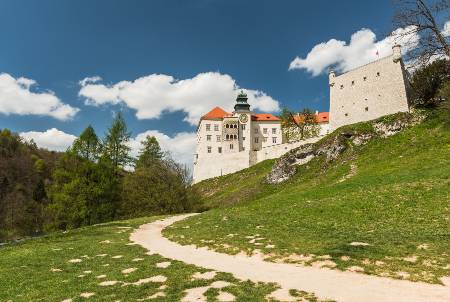
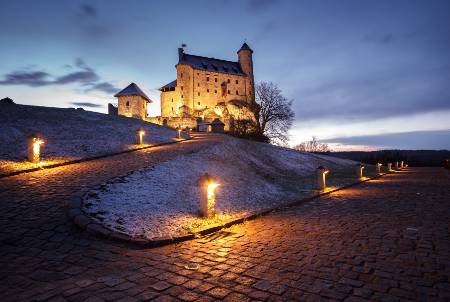
Pieskowa Skała Castle
Pieskowa Skała Castle is located 27 km from Krakow in the small village of Sułoszowa.
It represents one of the best examples of Renaissance architecture in Poland and is one of only three castles on the Trail of the Eagle’s Nests that is still intact.
Initially built as a defensive fortress, it later became the residence of the Szafraniec family. Today the castle houses a branch of the Wawel Castle Royal Museum, exhibiting splendid collections of art, painting, sculpture and crafts, as well as an exhibition dedicated to the history of Pieskowa Skała.
In addition, temporary exhibitions are also periodically organized. Many legends are told about the castle, among which the most famous is that of the former owner Piotr Szafraniec, sentenced to be beheaded in the 15th century. It is said that his ghost still roams the rooms of the castle today.
Rabsztyn Castle
The complex is located in the village of Rabsztyn and consists of two castles. The upper castle dates back to the 16th century while the lower one is from the 17th century, built in a Renaissance style.
In recent years, major renovations have been carried out which have made it possible to open visits to tourists. The upper castle with the towers was partially rebuilt, the lower castle tower with the main door was recreated and a wonderful wooden bridge was built that leads to the castles.
During the archaeological excavations, many ancient objects were found, including weapons and tools that are now on display in a small exhibition located inside the castle rooms. In July, medieval tournaments are often organized here, with knights in ancient medieval costumes.
Błędów Desert
Along the Trail of the Eagle’s Nests, about 40km from Krakow, you will come across a desert. Yes, you got it right: a desert in the heart of Europe. It is located in Pustynia Błędowska and is known as the Sahara of Poland. It represents the largest desert in central Europe with its 33 square kilometers.
The origin of the desert is not natural, but it was created by man. The area was already quite sandy, because there was a glacier here in prehistoric times. But it is after the Middle Ages that man made this place a desert, to meet the needs of the mining and metallurgical industries that were widely present here, up to a very aggressive deforestation, which extended for over 150 square kilometers.
Over time, the vegetation has returned to grow and to decrease the size of the desert, which in recent years has been the subject of conservation works.
The entrance is at Róża Wiatrów, a recreation area located in the southern part of the desert towards Klucze. Here are several information points and viewing platforms. From this point, with a short hike, you can reach an ancient military bunker in the desert.
There are also some hills, such as Czubatka Hill to the south and Dąbrówka Hill to the north, from which you can admire wonderful views over the expanse of the desert.
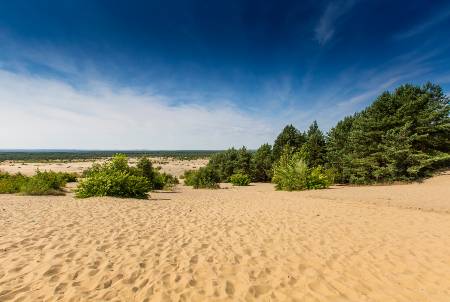
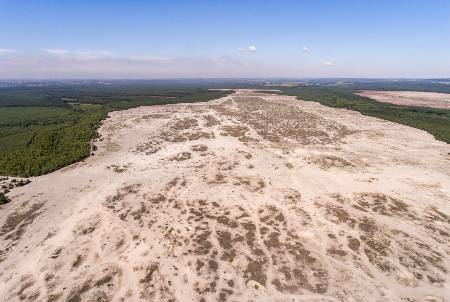
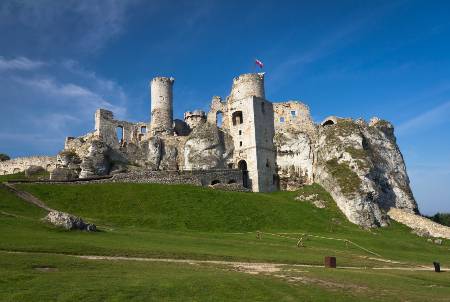
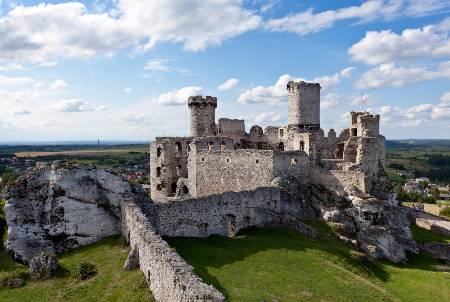
Ogrodzieniec Castle
Ogrodzieniec Castle is located in the village of Podzamcze, about an hour from Krakow. It is located on the top of the highest hill in the plateau, about 500 meters above sea level, surrounded by a beautiful landscape.
It was built in the 14th century and today represents one of the best examples of medieval architecture in Poland. Although for the most part it is surrounded by ruins, this castle is absolutely impressive and offers visitors an incredible atmosphere and panorama that makes it one of the most beautiful monuments in the entire nation.
For this reason Ogrodzieniec Castle is frequently chosen as a film location, for example the Netflix series “The Witcher” was filmed here. It is possible to visit the internal courtyard, the prison tower, the armory and the former chamber of the knights.
Mirów Castle
Mirów Castle was built in the 14th century in a tiny rural village. The ruins of the castle are currently undergoing major renovations, so you can only admire it from the outside, with its defensive walls and tower.
The castle is connected by a wonderful rocky path to the equally famous Bobolice castle. Between the two castles there is also a legend about the brothers Mir and Bobol, who in the past reigned over their respective castles. It is said that one day Bobol discovered that his wife was cheating on him with his brother Mir. Because of this Bobol killed his brother and after her locked his wife in the castle tunnel and eventually killed her. It is said that her ghost is still in the castle, awaiting the return of his lover Mir.
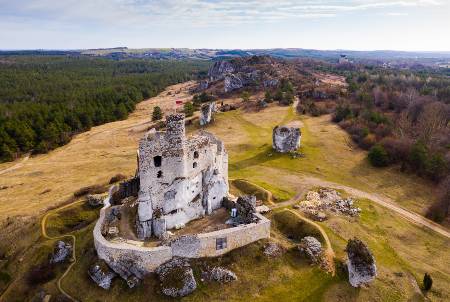
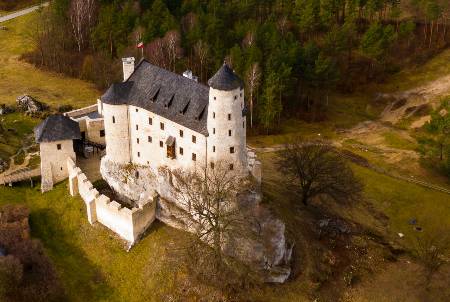
Bobolice Castle
The castle is located in the small village of Bobolice. It dates back to the 14th century but was subsequently beautifully restored by the Lasecki family, the current owner. Today Bobolice Castle looks a little too modern, but it’s interesting to admire the ancient defensive walls, which join together with magnificent limestone rocks.
Currently the castle is open to tourists and it is also possible to access the interior accompanied by a guide. The visit is very short, but allows you to admire different rooms, with the display of armor and paintings that recreate a typical medieval atmosphere.
There is also access to a terrace with a magnificent view of the plateau. The guide also tells the long and troubled history of the castle during the tour.
The castle is open from April to October from 10.00 to 18.00, while from November to March from 10.00 to 16.00.
The ticket price is 15 PLN (reduced 10 PLN).
How to Visit the Trail of the Eagle’s Nests from Krakow
Most travelers visit the Trail of the Eagle’s Nests on a day trip from Krakow. There are guided tours that allow you to visit all the main places, the most impressive castles and even the Bledow Desert, and include transport and an English-speaking guide.
Otherwise it is also possible to visit it with a road trip of 1-2 days. You can easily rent a car in Krakow, as the rental rates are quite cheap.
☞ Here you can find a Guide to the Best Car Rentals in Krakow
The route is easily accessible by car, and there is also a beautiful cycle path along the entire path. The route runs from Krakow and Czestochowa, and can be traveled in both directions. The route is well marked by clearly visible and very frequent signs.
Best Places to Eat along the Trail of the Eagle’s Nests
Herbova Restauracja & Kawiarnia
This restaurant is located very close to the Pieskova Skala castle and serves good traditional Polish dishes, with soups, first courses and pierogi. The interiors are in stone, but the style is quite modern. They also have a beautiful terrace, from which you have a great view of the castle.
Stodoła
This restaurant is located very close to Ogrodziniec Castle and serves good regional cuisine in a quaint and rustic venue with a small internal garden.
Podzamcze
This small family-run restaurant is located near the Rabsztyn Castle and serves good Polish cuisine, soups and meat and fish specialties. The portions are generous and the prices quite cheap. In summer you can also dine outdoors.
Best Places to Stay along the Trail of the Eagle’s Nests
Hotel Zamek Bobolice
The Hotel Zamek Bobolice is located just 20 meters from the famous Bobolice Castle and offers its guests rooms with a wonderful view of the castle and the plateau.
All rooms are equipped with private bathroom and every comfort. There is also a restaurant, serving regional specialties in a modern style. For those traveling by car, the hotel offers free private parking.
Chata w Mirowie
The Chata w Mirowie offers beautiful log cabins, located within walking distance of the Mirów Castle. They are equipped with every comfort and guests have access to free private parking, an outdoor swimming pool and a barbecue in the garden. It is located near the paths and the cycle path, and is an excellent starting point for excursions on the plateau.
Jurajskie Pokoje Pod Lasem
Jurajskie Pokoje Pod Lasem is located 29 km from Ogrodzieniec and 2 km from Bobolice Castle. Surrounded by forests and limestone rocks, it offers rooms with private bathroom and a small kitchen, with fridge and kitchenette. The property also has a children’s play area and a sun terrace.
Zamek Korzkiew
The Zamek Korzkiew hotel is located inside the marvelous Korzkiew fortress. This small and prestigious hotel has only 4 rooms, all furnished with great elegance, with authentic antiques and a beautiful fireplace in each.
One of them is located inside the tower, which is accessed by a narrow and fairly long staircase. The beauty of the room, equipped with a small mezzanine, is absolutely worth the effort.
The property also has a wonderful garden with barbecue, and in the morning a hearty international breakfast is served.
Useful Tips for Your Trip
Many people choose to visit the Trail of the Eagle’s Nests from Krakow, so here you can find the best useful tips to better plan your trip to Krakow and the wonderful region of Southern Poland: